The report by JPMorganChase’s Center for Geopolitics, published in May 2025, predicts that the current year will mark a turning point in Russia’s war against Ukraine. Due to resource depletion, declining public support, and growing divisions among allies, both sides may be forced to enter negotiations. However, the authors warn that any compromise is unlikely to lead to lasting peace. The most probable outcome is a partial "freeze" of the conflict and Ukraine’s slide into a zone of instability. This, in turn, could accelerate political divergence between the United States and Europe and call into question the future of the continent’s security architecture.
Four Scenarios—and No Clear Winner
The report by JPMorganChase’s Center for Geopolitics suggests that the outcome of the war in Ukraine should not be seen as a binary choice between victory and defeat, but rather as a spectrum of politically feasible compromises—each carrying its own risks. The analysts outline four scenarios, each illustrated by a real-world precedent: South Korea, Israel, Georgia, and Belarus.
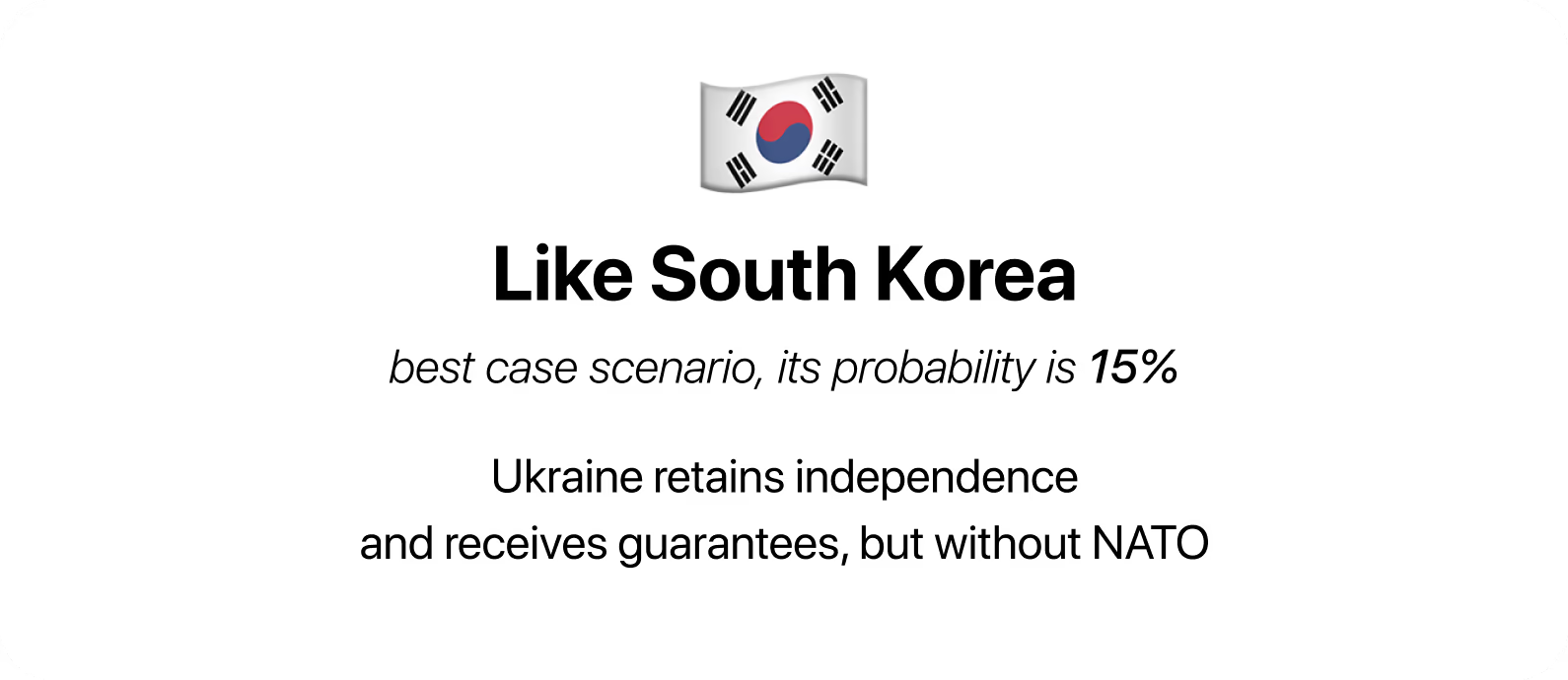
The least likely scenario—assigned a 15% probability by the authors—is the optimistic "South Korea" model. It envisions Ukraine, without NATO membership or full territorial restoration, hosting foreign troops on its controlled territory and receiving security guarantees from the United States. Complemented by the use of frozen Russian assets for reconstruction, this arrangement could provide stability and long-term development. However, it would require a high level of political will from Western allies—at a time when their resources, unity, and attention are under strain.
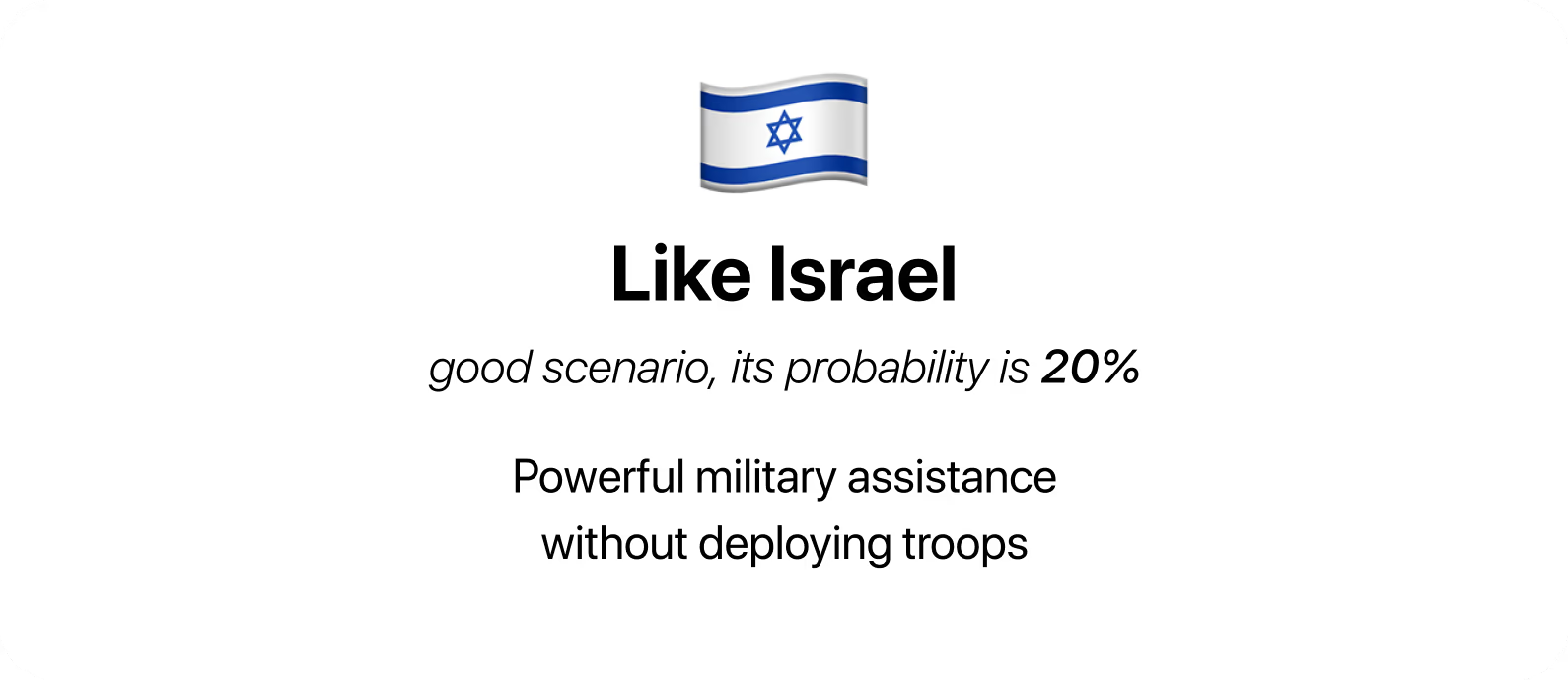
The "Israel" scenario—assigned a 20% probability—assumes sustained military aid to Ukraine without the physical presence of allied troops. Kyiv would be able to build its own deterrent capabilities but would remain under constant threat. In this case, Russia might agree to a partial withdrawal in exchange for economic concessions—ranging from sanctions relief to the restoration of diplomatic channels.
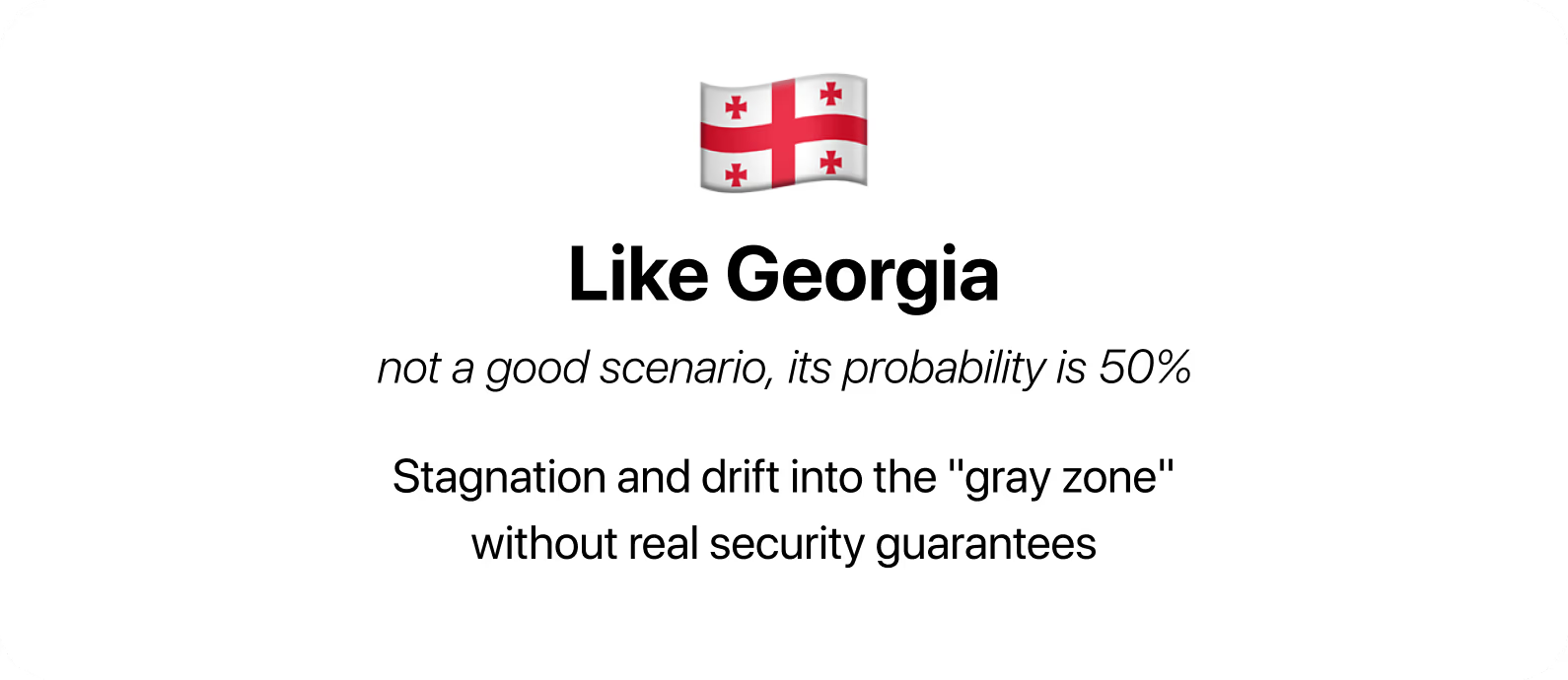
The most likely scenario—assigned a 50% probability by the analysts—is the "Georgia" model: no clear security guarantees, an unstable political environment, waning interest from external donors, and institutional drift. In this case, Ukraine remains outside NATO and the EU, while economic and demographic instability hampers recovery. Potential restrictions on the military and weaponry—agreed as part of a political compromise—further weaken the country’s internal capacity.
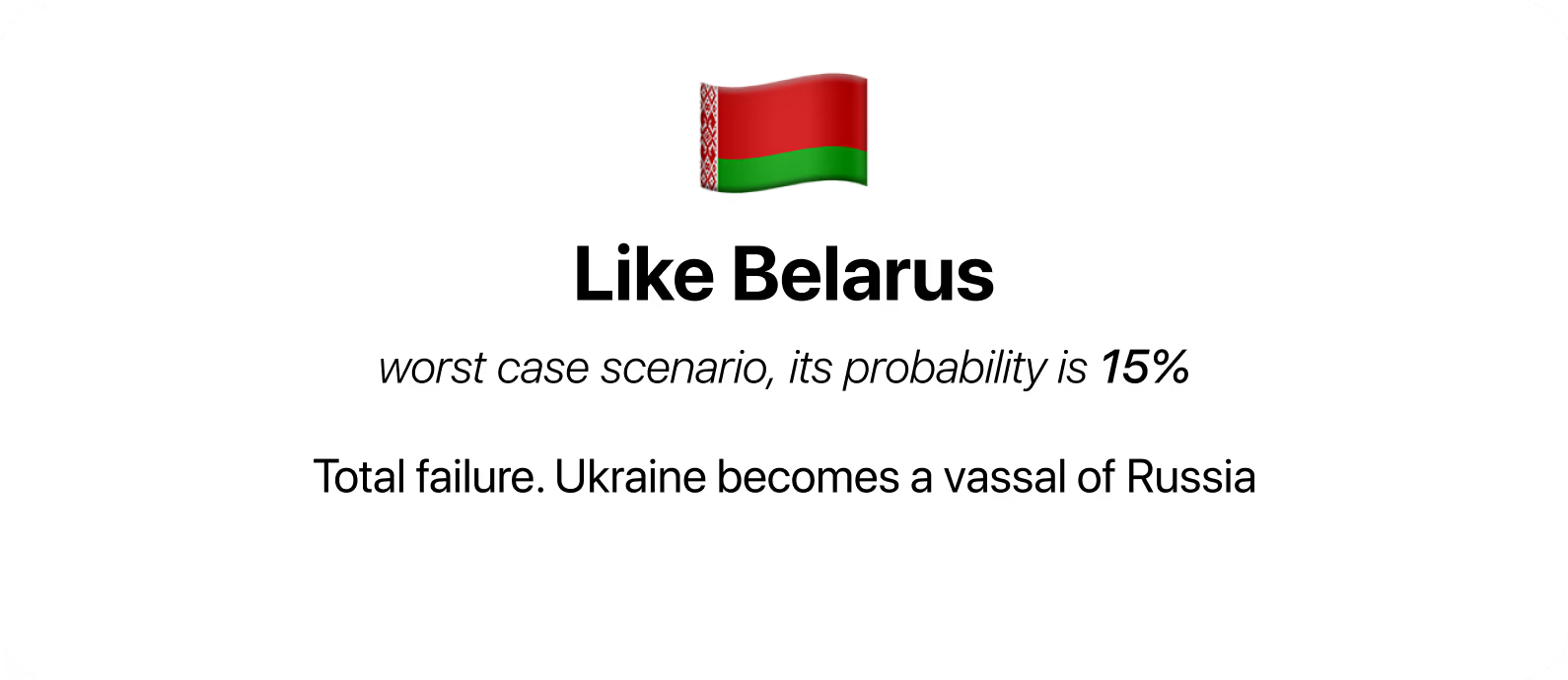
The worst-case scenario—"Belarus," assigned a 15% probability—could materialize if U.S. support drops sharply and Europe remains passive. In this case, Ukraine would become a vassal state of Moscow, and the West would lose leverage both in the region and within the broader architecture of the postwar world.
A common feature of all the scenarios is that none envisions the full restoration of Ukrainian control over all territories annexed by Russia since 2014. As the authors of the report emphasize, any compromise is likely to formalize a status quo that both sides can justify politically at home—not as a final settlement, but as a temporary ceasefire.
The Kremlin’s Terms: 12 Points of Pressure
As the prospect of a possible settlement grows, the document outlines key conditions put forward by the Russian side. These demands fall into two categories: the "Six No’s" and the "Six Yes’s." They reflect not a drive for stability, but an effort to codify a new balance of power favorable to Moscow.
The Six "No’s":
• No NATO membership for Ukraine — rejection of Euro-Atlantic integration and declaration of neutral status;
• No nuclear weapons or nuclear umbrella guarantees — exclusion of any form of strategic deterrence;
• No foreign troops — ban on the presence of any foreign forces, including peacekeepers;
• No military aid or intelligence sharing — severing coordination channels with the West;
• No large Ukrainian army — reduction of armed forces to a level incapable of defensive operations;
• No modern weaponry — ban on the supply of long-range and advanced weapons systems.
The Six "Yes’s":
• Yes to recognition of Crimea and the four annexed regions — legitimization of territorial gains;
• Yes to a Russian veto over Ukraine’s external guarantees — institutionalization of Ukraine’s dependence on the Kremlin;
• Yes to a ban on NATO military exercises in new member states — restriction of military activity on the alliance’s eastern flank;
• Yes to limits on U.S. troop numbers in Europe — reduction of the American presence in the region;
• Yes to lifting sanctions and unfreezing assets — economic relief and access to frozen reserves;
• Yes to the return of Russian diplomatic properties in the U.S. — restoration of symbolic and practical channels of influence.
Each of these points not only reflects Moscow’s current negotiating stance, but also sets the framework for potential pressure on Ukraine and its partners. Depending on the level of international support, Kyiv will either be able to reject most of these demands—or be forced to accept some of them in exchange for a ceasefire and economic assistance.
The authors of the report emphasize that the strength of Western guarantees and the resolve of Ukraine’s allies will be the decisive factor in determining how many of these demands make it into a final agreement. A weakening of U.S. commitments or internal divisions within the EU could shift the negotiating framework toward Russian terms—particularly on issues of security and sovereignty.
European Security: From Post-War to Pre-War Mode
The JPMorganChase report highlights an accelerating shift in Europe’s security architecture. While Russia’s invasion of Ukraine initially prompted the continent to strengthen its defense and energy mechanisms, recent fluctuations in U.S. policy have become an additional catalyst.
The authors identify a key turning point in President Volodymyr Zelensky’s visit to Washington on February 28, 2025, which was followed by a temporary suspension of U.S. military and intelligence support. This signal—amplified by the U.S. vote against an anti-Russian resolution at the UN Security Council—was interpreted in European capitals as evidence of increasing unpredictability from their main ally. As a result, momentum has grown for "strategic autonomy," a long-discussed concept that is now entering a phase of political implementation.
German Chancellor Friedrich Merz, who delivered a keynote speech outlining the need for defense independence from the U.S., has become a symbol of this new course. France and several Benelux countries have also voiced support for deeper integration in defense and arms manufacturing. However, there is still no consensus on how far this effort should go—or how responsibilities should be divided.
Despite Ambitious Statements, Structural Constraints Remain Significant:
• In 2024, the EU’s total defense spending amounted to 1.9% of GDP—nearly half the level of U.S. expenditures;
• Financing mechanisms—particularly borrowing limits and budget deficit rules—restrict large-scale investments;
• Domestic political instability in countries like Italy and Hungary complicates decision-making and coordination;
• There is no clear political leadership capable of aligning efforts—neither France nor Germany commands sufficient consensus within the EU, while the UK remains outside the formal framework.
The authors emphasize that Europe’s defense industrial base (DIB) is not aligned with current strategic demands. Although Brussels is discussing initiatives to expand it—including lifting fiscal constraints on defense spending—actual progress remains limited.
In this context, Europe is shifting from the logic of a "postwar peace" toward the realization that it must prepare for a potential future conflict. Yet without a clear roadmap and coordinated action, calls for autonomy may remain rhetorical—especially amid growing pressure from China and increasing internal political fragmentation.
Economic Leverage: The Fate of Russia’s Frozen Assets
One of the few remaining tools the West has to influence the course of the war and Ukraine’s postwar recovery is the pool of frozen Russian assets. According to JPMorganChase, these amount to roughly $300 billion, two-thirds of which are under EU jurisdiction. These funds not only symbolize Russia’s financial isolation but also represent a potential source of financing for rebuilding Ukraine’s devastated infrastructure.
However, the fate of these assets remains uncertain. The EU’s sanctions renewal mechanism requires unanimous approval every six months, and the next deadline is July 31, 2025. If even one country—such as Hungary—refuses to support the extension without a decision on confiscation, the sanctions regime could lapse and the assets be returned to Russia.
Such an outcome would have a dual effect:
• Russia would gain a major boost for economic recovery and rearmament;
• Ukraine would lose one of the few potential financial resources to cover damages currently estimated at over $500 billion.
As an alternative, the funds could be directed into a Ukraine Reconstruction Fund—helping to offset damages, attract private investment, and strengthen Kyiv’s position in negotiations. However, this scenario would require both the political will and legal infrastructure to justify the lawful seizure of the frozen assets.
At a time when military supplies are shrinking and political support is becoming more fragmented, economic measures are taking on strategic importance. As the report emphasizes, if Europe fails to act in time, it risks losing not only a key lever over the outcome of the conflict, but the credibility of the sanctions architecture itself.
June Signals: Summits, Meetings, and Windows of Opportunity
JPMorganChase analysts emphasize that June 2025 could prove to be a critical moment for shaping the future of peace negotiations, European autonomy, and the U.S. role in the conflict. This month will see several high-profile events—each serving not only as a platform for official statements but also as a barometer of the real state of international affairs.
Key Events in June
June 15–17
G7 Summit in Canada
June 24–26
NATO Summit in The Hague
June 26–27
European Council Meeting
On the agenda: restoring Western unity, aligning positions on Ukraine, and discussing the future of European security architecture. The level of coordination across these platforms will determine how persuasive the West’s collective signal appears—to both Kyiv and Moscow.
A Potential Diplomatic Precedent: A Trump–Putin Meeting
The report draws particular attention to Donald Trump’s stated intention to hold a personal meeting with Vladimir Putin. If it takes place, the meeting would become a global diplomatic event—symbolically comparable to the Biden–Putin summit in Geneva in 2021. However, its outcome could prove just as controversial as Trump’s 2018 summit with Putin in Helsinki, where the U.S. effectively abandoned a hardline stance toward Russia.
Risks and Uncertainties
• Reduction of U.S. military presence. Around 90,000 American troops are still stationed in Europe. But as the authors note, some of them are almost certain to be withdrawn within the next year.
• Trade tensions between the U.S. and the EU. Washington’s introduction of new tariffs—ranging from 10% across the board to 25% on steel, aluminum, and automobiles—has complicated negotiations and fueled debates about protectionism and Europe’s "economic autonomy."
• Possible unfreezing of Russian assets. A failure to renew sanctions or legal ambiguity around asset confiscation could weaken the EU’s negotiating position and contribute to instability.
• China’s role. Chinese diplomacy is gaining momentum amid the cooling of U.S.–EU relations. The upcoming EU–Xi Jinping summit this summer could mark a shift toward rapprochement—especially in light of divisions within the West.
• Resource vector. The agreement signed on April 30 between the U.S. and Ukraine on mineral extraction cooperation is a step toward strategic partnership. However, up to 40% of these resources are located in occupied territories, and infrastructure-related costs remain uncertain.
Unpeace
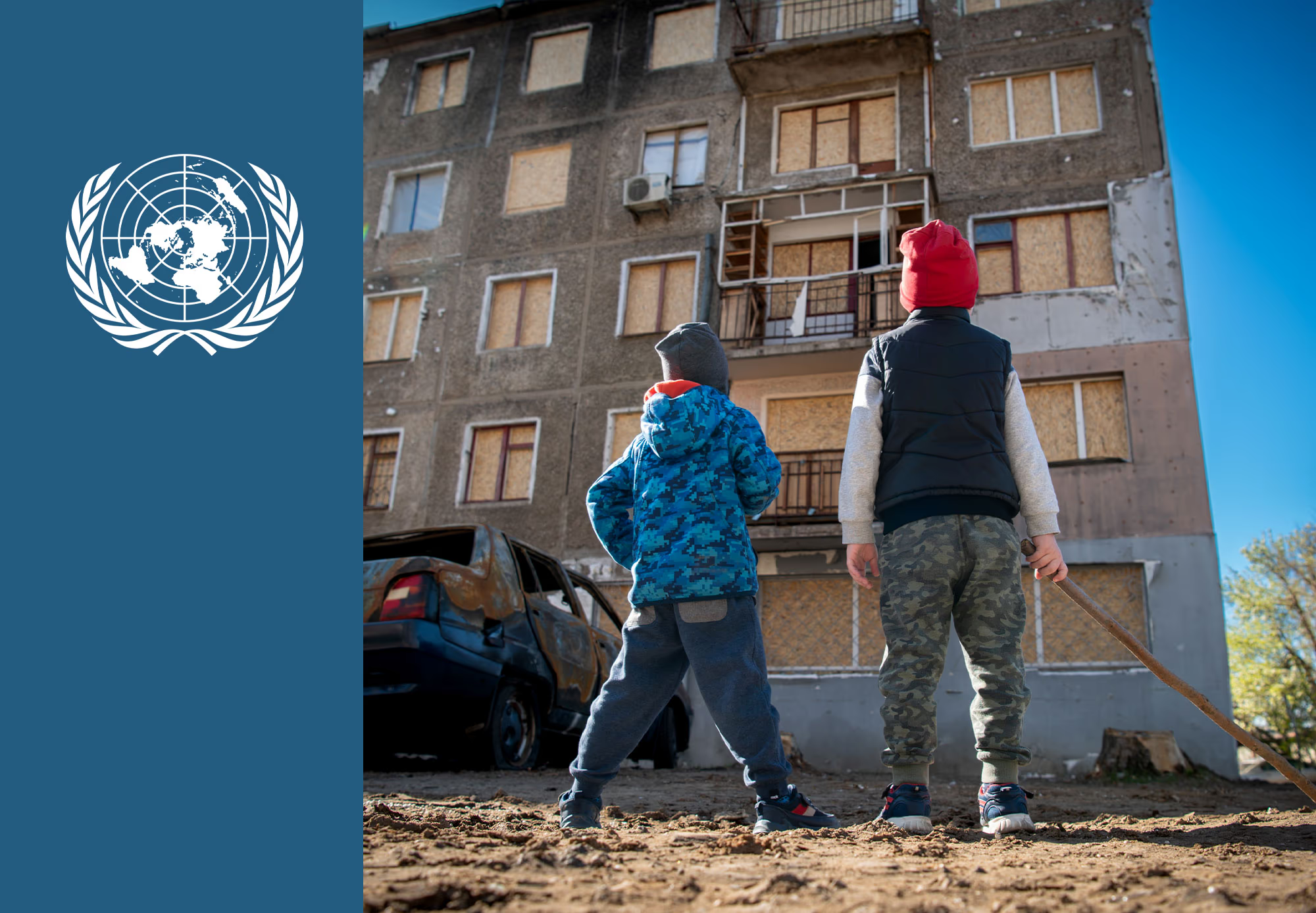
UN Report Documents Systemic Human Rights Violations in Ukraine

Trump Shifts His Ukraine Position in Hopes of Concessions From Putin—Which Have Yet to Materialize

The Crimea Deal: How the Bloodless Annexation of 2014 Paved the Way for New Concessions to Moscow
As Kyiv Holds the Front, the West Debates Whom to Blame and Where to Cut Costs

"Would a U.S. President Risk Dying for Tallinn, Riga and Vilnius?"
Moscow Seems Ready to Find Out—An Interview With Germany’s Intelligence Chief

13 Killed After Massive Russian Drone and Missile Attack on Ukraine

Overnight Strikes on Kyiv and Odesa
Civilians Killed, Homes and Maternity Hospital Destroyed—Photos From the Scene

Why Trump’s Peace Plan Is Stalling
Hard Lessons From the 2022 Talks

